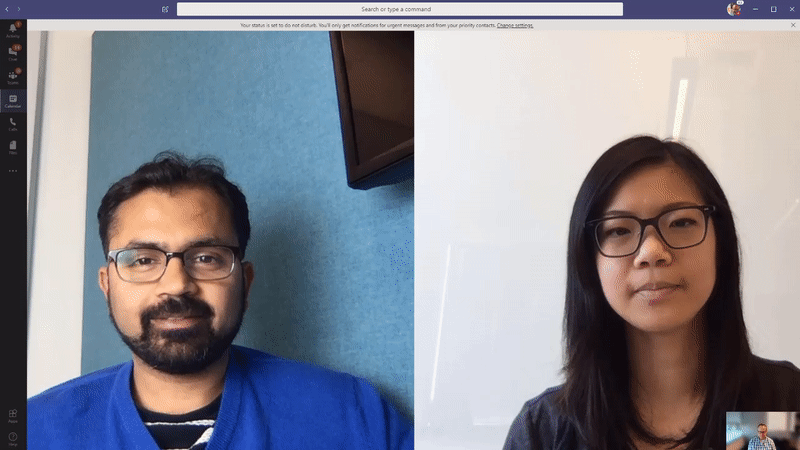
5 tips to keep your remote team engaged and motivated
I recently changed roles at Microsoft. After six happy years working in our Global Talent Acquisition team, the last three of which supporting a dispersed team across the Middle East and Africa region, I moved back into a UK role in our Services business as a Delivery Management Leader.
During my last role, I managed my team remotely from the UK. We were spread across seven different geographical locations, four different time zones, and were as diverse a team as you might expect for a region encompassing 78 countries. During my 3.5 year tenure we were able to be together as a whole team on only one occasion – for an organisational off-site.
Despite the distance between us, I am proud to have fostered a close and collaborative team culture during that time, one which respected and celebrated our diversity.
This wasn’t without its challenges, however. Maintaining an inclusive environment and ensuring connection required both attention and intention. Managing a team remotely and from home was a great learning experience for me as a people leader. I am keen to share some of my thoughts, learnings and mistakes that were made along my journey in the hope to help you with yours.
Here are my top five tips for managing remotely and from home.
1. Make sure you are prepared

First things first – make sure that you are ready and set up to productively lead and manage remotely when at home. I remember sharing a particularly embarrassing incident with my team early on in my remote working experience. I was on a call with a senior leadership team when I noticed I was losing WiFi signal. In an attempt to regain the signal, I sprinted with my laptop to another part of the house and tripped over the dog. I accidentally unmuted myself at the exact point in time when I let out a loud expletive aimed at said canine. The leadership team were especially forgiving, although I think the dog still holds a grudge! It was a valuable lesson in the importance of getting set up to credibly and productively manage remotely:
- Prepare your workspace. Make sure you have a reliable connection and you have what you need to be productive.
- Figure out when you really need the focus time. Not all calls and meetings are equal in this regard. We all have distractions when working from home such as partners, kids, pets etc. If I had an especially important call, for example, with a customer or if I was required to present, then that was the time I found a way to create calm, e.g. asking my husband to take the dogs out, putting a movie on for the kids, or asking the builders (yes really) to hold back on the pneumatic drilling for an hour or so.
- Embrace the quirks. For those other calls which are a more informal catch ups like 1:1s and team meetings then my view is that we’re all adults and nobody really cares if a dog barks, postman arrives or a child comes in. I was once on a call where my bosses partner appeared in full view in swimming trunks behind her on a Teams call. In a fully remote team some of these moments provided the best social moments of connection.
- Set your boundaries. It is important that you still maintain a healthy separation between home and work life even if you are working from your home. Be intentional about your working hours and setting expectations for availability. This is especially important if working in a global company and across cultures and time zones.
2. Prioritise the relationships

In my previous roles I had been used to managing people with a rhythm of 1:1 meetings on a monthly basis in order to review progress and check-in. Being based in the same office if there was ever a requirement for an interim chat, decision, or catch up we knew we would see each other and so there were plenty of other opportunities to connect – normally in a corridor, in the kitchen, or just wandering over to someone else’s desk.
Managing remotely however is different and these are some of the learnings I discovered as a result:
- Frequent contact is important. In order to maintain connection and build the manager-direct report relationship, I consciously doubled the frequency of 1:1 meetings or check-ins with my direct reports as I had done with my local office based team. I had catch ups every other week for most of the team, but for new joiners or where we had business challenges, I did a weekly meeting. These connections were invaluable for keeping in sync with the team and it was the frequency, rather than the length of these connections which was important.
- Welcome the ‘ping’. I made sure my status was accurate and welcomed the informal ‘pings’, quick asks for help, and kept a close eye on this throughout the day. It’s important that you are accessible to your team when they need support.
- Maximise opportunities for connection. Whenever possible I prioritised an informal ad-hoc Teams video chat over sending an email when I could to encourage relationship building and make sure things we’re taken out of context.
3. Running inclusive remote meetings:
I have found the phrase “if you don’t intentionally include you unintentionally exclude” to be so true. In the early days of remotely managing my team it became obvious that only a few voices were being heard. It took deliberate attention to foster a feeling of inclusion on our calls where every voice could be heard. Over time we found what worked for us and these are my top tips:
- Don’t try to pack too much into the meeting agenda. Whilst it’s tempting to get everything crammed into the meeting, this might not leave enough space for discussion amongst the team. Put lower priority items at the end of the agenda so if you happen to overrun then you can start with those next time.
- Allow time for social connection. Whilst you are waiting for everyone to join, rather than sitting in silence, use the time to catch up on what happened at the weekend, the weather, family life, etc. Anything to build those social connections in the group.
- Turn on the camera. It makes such a difference to the engagement of a remote team when they can see each other on the call. You can do this by putting a fun slide/reminder at the start of the call as a quick prompt and as a manager, modelling the way by being the first to turn your camera on.
- Consider a ‘check-in’. A check-in usually takes the form of a quick update from each of the meeting participants and is perfect if you have a relatively small team. This could be to see how they are feeling, whether they are facing any challenges, and what they are looking forward to amongst other things. The important factor here is to engage all participants from the outset of the call.
- Let your team build the agenda. Another trick to get participation is to ask everyone to input topics they’d cover in your meetings. Once you have a list of topics from everyone, you can prioritise by having everyone “+1” on the topics they care about, and work through them in that order to maximise coverage of interest in the topics during the time you have. Carry over any items which were not covered to the next meeting/call.
- Notice who is speaking and who is quiet. Try to encourage active participation of all on the call. Invite other opinions if some of the team are not contributing and don’t feel comfortable jumping in every time there is silence on the call.
- Rotate meeting ownership. Ask other members of the team to present content on the call, or even organise the agenda for the call on behalf of the team.
- Record the meeting. If team members are unable to attend this means they can review the content later. Recorded meetings also come with the audio transcript so team members can easily go back to review meetings and get actions.
- Turn on live captions. Teams uses AI to put live captions onto meetings in real-time. This is useful for members who might be joining from a busy environment, or are hard of hearing.

4. Promoting collaboration

When a team is remote, and not just remote but working in isolation and/or outside of the office then the chat functionality of Teams really becomes important. However, if this is new to an individual – either because they are used to working in an office or are new to a team then here are a few tips to promote collaboration.
- Promote an open and supportive culture. Create a safe space where your team are empowered to share problems and challenges in your Teams channels (as well as ideas, best practices, and offers of help. Using the power of your community to support each other should enable faster resolution to issues and everyone’s knowledge benefits from seeing the conversation. As a manager you can ‘like’, @mention someone and recognise with thanks both the question and the contribution of the team.
- Get to the point in Team chats. Some organisations and Teams are promoting a ‘NoHello’ approach to chat conversations. Although we love to be polite, share a greeting and wait for a response which might take minutes to come, you may have joined your next meeting before you get what you need. Make it a practice in your organisation, by all means to share a greeting – but follow this straight away by the question or request. Much quicker and more respectful of time.
5. Don’t forget the Fun
We all have a limited attention span in meetings and in particular, on remote calls. That’s why it’s important to keep the engagement, attention, and energy up. Some of the great ways we found to do this were:
- Use the chat function. On our Teams meetings, we encouraged equal levels of engagement and participation in the chat window as we did in speaking on the call. Everyone loves a GIF or a meme. Typically, alongside any speaker or presentation there was a constant stream of chat, feedback, questions, comments, and activity throughout the session.
- Use the full functionality of Teams. You could use the whiteboard to brainstorm ideas (or for a quick round of Pictionary), and the poll functionality to gauge opinions (or for a quick trivia quiz). Being mindful to inject some lighter moments of fun into the meeting will create deeper levels of engagement and participation when used during the meeting.
Find out more
Tips for effective remote work
Join our virtual Microsoft 365 Training Day: Journey to Microsoft Teams
About the author
 Georgina is Delivery Management Leader in Microsoft Services, where she helps customers realise their full potential through accelerated adoption and productive use of Microsoft technologies. She leads a high-performance team of seasoned service delivery professionals well versed in cloud adoption, delivery management practices, and technology trends. Previously, she was Head of Talent Acquisition for Middle East and Africa. Georgina is passionate about coaching and developing individuals to achieve their potential, with an interest in diversity and inclusion.
Georgina is Delivery Management Leader in Microsoft Services, where she helps customers realise their full potential through accelerated adoption and productive use of Microsoft technologies. She leads a high-performance team of seasoned service delivery professionals well versed in cloud adoption, delivery management practices, and technology trends. Previously, she was Head of Talent Acquisition for Middle East and Africa. Georgina is passionate about coaching and developing individuals to achieve their potential, with an interest in diversity and inclusion.




